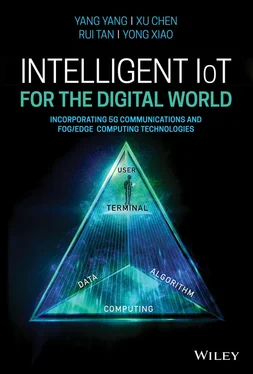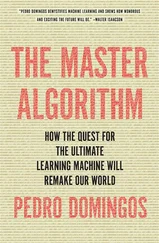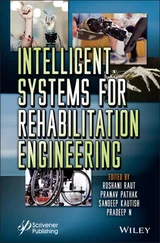Chapter 5addresses the privacy concerns in public IoT applications and services, where IoT devices are usually embedded in a user's private time and space, and the corresponding data is in general privacy sensitive. Unlike resourceful clouds that can apply powerful security and privacy mechanisms in processing massive user data for training and executing deep neural network models to solve complex problems, IoT devices and their nearby edge/fog nodes are resource‐limited, and therefore, have to adopt light‐weight algorithms for privacy protection and data analysis locally. With low computing overhead, three approaches with different privacy‐preserving features are proposed to tackle this challenge. Specifically, random and independent multiplicative projections are applied to IoT data, and the projected data is used in a stochastic gradient descent method for training a deep neural network, thus to protect the confidentiality of the original IoT data. In addition, random additive perturbations are applied to the IoT data, which can realize differential privacy for all the IoT devices while training the deep neural network. A secret shallow neural network is also applied to the IoT data, which can protect the confidentiality of the original IoT data while executing the deep neural network for inference. Extensive performance evaluations based on various standard datasets and real testbed experiments show these proposed approaches can effectively achieve high learning and inference accuracy while preserving the privacy of IoT data.
Chapter 6considers clock synchronization and service reliability problems in wide‐area IoT networks, such as long‐distance powerlines in a state power grid. Typically, the IoT systems for such outdoor application scenarios obtain the standard global time from a Global Positioning System (GPS) or the periodic timekeeping signals from Frequency Modulation (FM) and Amplitude Modulation (AM) radios. While for indoor IoT systems and applications, the current clock synchronization protocols need reliable network connectivity for timely transmissions of synchronization packets, which cannot be guaranteed as IoT devices are often resource‐limited and their unpredictable failures cause intermittent network connections and synchronization packet losses or delays. To solve this problem, a natural timestamping approach is proposed to retrieve the global time information by analyzing the minute frequency fluctuations of powerline electromagnetic radiation. This approach can achieve sub‐second synchronization accuracy in real experiments. Further, by exploiting a pervasive periodic signal that can be sensed in most indoor electromagnetic radiation environments with service powerlines, the trade‐off relationship between synchronization accuracy and IoT hardware heterogeneity is identified, hence a new clock synchronization approach is developed for indoor IoT applications. It is then applied to body‐area IoT devices by taking into account the coupling effect between a human body and the surrounding electric field generated by the powerlines. Extensive experiments show that this proposed approach can achieve milliseconds clock synchronization accuracy.
Finally, Chapter 7concludes this book and identifies some additional challenging problems for further investigation.
We believe all the challenges and technical solutions discussed in this book will not only encourage and enable many novel intelligent IoT applications in our daily lives but, more importantly, will deliver a series of long‐term benefits to businesses, consumers, governments, and human societies in the digital world.
Yang Yang
ShanghaiTech University and
Peng Cheng Laboratory, China
August 19, 2020
1 1Bernard Marr, What is Digital Twin Technology and Why is it so Important?, Forbes, March 6, 2017.
2 2Cisco, Cisco Annual Internet Report (2018–2023), February 2020.
3 3Scott Buchholz and Bill Briggs, Tech Trends 2020, Deloitte, January 7, 2020.
4 4Keynote by Alexandra Rehak and Steve Bell, IoT World, May 14, 2019.
5 5Yigang Cai, 3GPP Release 16, IEEE Communications Society Technology Blog, 10 July 2020.
6 610 Breakthrough Technologies 2020, MIT Technology Review, February 26, 2020.
7 7David Reinsel, John Gantz, and John Rydning, Data Age 2025, The Digitization of the World: from Edge to Core, IDC and SEAGATE, November 2018.
8 8Worldwide Big Data and Analytics Spending Guide, IDC, April 2019.
9 9David Reinsel, John Gantz, and John Rydning, Data Age 2025, The Digitization of the World: from Edge to Core, IDC and SEAGATE, November 2018.
10 10N. Chen, Y. Yang, T. Zhang, M. T. Zhou, X. L. Luo, and J. Zao, “Fog as a Service Technology,” IEEE Communications Magazine, Vol. 56, No. 11, pp. 95–101, November 2018.
11 11Y. Yang, “Multi‐tier Computing Networks for Intelligent IoT,” Nature Electronics, vol. 2, pp. 4–5, January 2019.
12 12David W. Cearley, Top 10 Strategic Technology Trends for 2020, Gartner, October 21, 2019.
We would like to thank all the people who have made contributions to this book. In particular, we want to acknowledge the enormous amount of help we received from Yang Liu, Zening Liu, Lei Zhu, Zhouyang Lin, and Guoliang Gao at School of Information Science and Technology, ShanghaiTech University, China; Zhi Zhou, Liekang Zeng, and Siqi Luo at Sun Yat‐sen University, China; Anqi Huang and Rong Xia at Huazhong University of Science and Technology, China; Linshan Jiang, Guosheng Lin, Jun Zhao, Mengyao Zheng, Dixing Xu, Chaojie Gu, and Zhenyu Yan at Nanyang Technological University, Singapore; Xin Lou and Yang Li at Advanced Digital Sciences Center, Singapore; David Yau at Singapore University of Technology and Design; Peng Cheng at Zhejiang University, China; and Jun Huang at Massachusetts Institute of Technology, USA.
In addition, we want to express our gratitude to our colleagues for their kind support and encouragement. Last but not least, this book has been partially supported by the National Key Research and Development Program of China under grant 2020YFB2104300, the Program for Guangdong Introducing Innovative and Entrepreneurial Teams under grant 2017ZT07X355, the Singapore Ministry of Education AcRF Tier 1 grant 2019‐T1‐001‐044, and the National Natural Science Foundation of China (NSFC) under grant 62071193.
2CComputing and Communication3CComputing, Communication and Caching3GPPthe Third Generation Partnership Project5GFifth GenerationADCanalog‐to‐digital converterAFEanalog front‐endAIArtificial IntelligenceAMAmplitude ModulationASTAArrivals See Time AveragesBHCABusy Hour Call AttemptsBNBusy NodeBPFband‐pass filterBRBandwidth ReservationBSBase StationCAGRCompounded Annual Growth RateCATSCost Aware Task SchedulingCCPACalifornia Consumer Privacy ActCDCCloud data centerCDFCumulative Distribution FunctionCNoTcommon notion of timeCSPClock Synchronization ProtocolC‐V2Xcellular vehicle‐to‐everythingDNNdeep neural networkDRLdeep reinforcement learningDSRCDedicated Short Range CommunicationsEDCEdge Data CentereMBBenhanced mobile broadbandFFTfast Fourier transformFMFrequency ModulationFNFog NodeFTSPFlooding Time Synchronization ProtocolGAPgeneralized assignment problemGDPRGeneral Data Protection RegulationGPSGlobal Positioning SystemGRPGaussian random projectionH2Mhuman‐to‐machineHDPHealth Device ProfileHetVNETHeterogeneous Vehicle NETworkHNHelper NodeICNInformation‐Centric NetworkingIIRinfinite impulse responseIMT‐2020International Mobile Telecommunications‐2020IMUInertial Measurement UnitIoITInternet of Intelligent ThingsIoTInternet of ThingsLPCClinear prediction coefficientsLPWALow power wide areaLTE‐VLong Term Evolution for VehicleM2MMachine‐to‐machineMANETMobile ad hoc networkMCCMobile Cloud ComputingMECMobile/Multi‐access Edge ComputingmMTCmassive machine type communicationsMPCMulti‐party ComputationMRFmean removal filterMTCMachine‐type CommunicationsMTMHMultiple Tasks and Multiple HelpersNB‐IoTNarrowband IoTNGMNNext‐Generation Mobile NetworkNOMANon‐Orthogonal Multiple AccessPDFprobability density functionPLLPhase‐locked LoopPOMTPaired Offloading of Multiple TasksPOSTParallel Offloading of Splittable TasksPRACHPhysical Random Access ChannelPTPPrecision Time ProtocolQoSQuality of ServiceR&DResearch and DevelopmentRACHRandom Access ChannelRANRadio Access NetworkRBSReference‐Broadcast SynchronizationRMSEroot mean square errorRTTRound‐trip‐timeSD‐WANsoftware‐defined wide area networkSLAMSimultaneous Localization and MappingSoAService‐oriented ArchitectureTDMATime Division Multiple AccessTEETrusted Execution EnvironmentTNTask NodeTPSNTiming‐sync Protocol for Sensor NetworksUEUser EquipmentURLLCUltra Reliable Low Latency CommunicationsUWBUltra WideBandVANETVehicular Ad‐hoc NETworkVR/ARvirtual/augment realityZBzettabytesZCDzero crossing detection
Читать дальше












